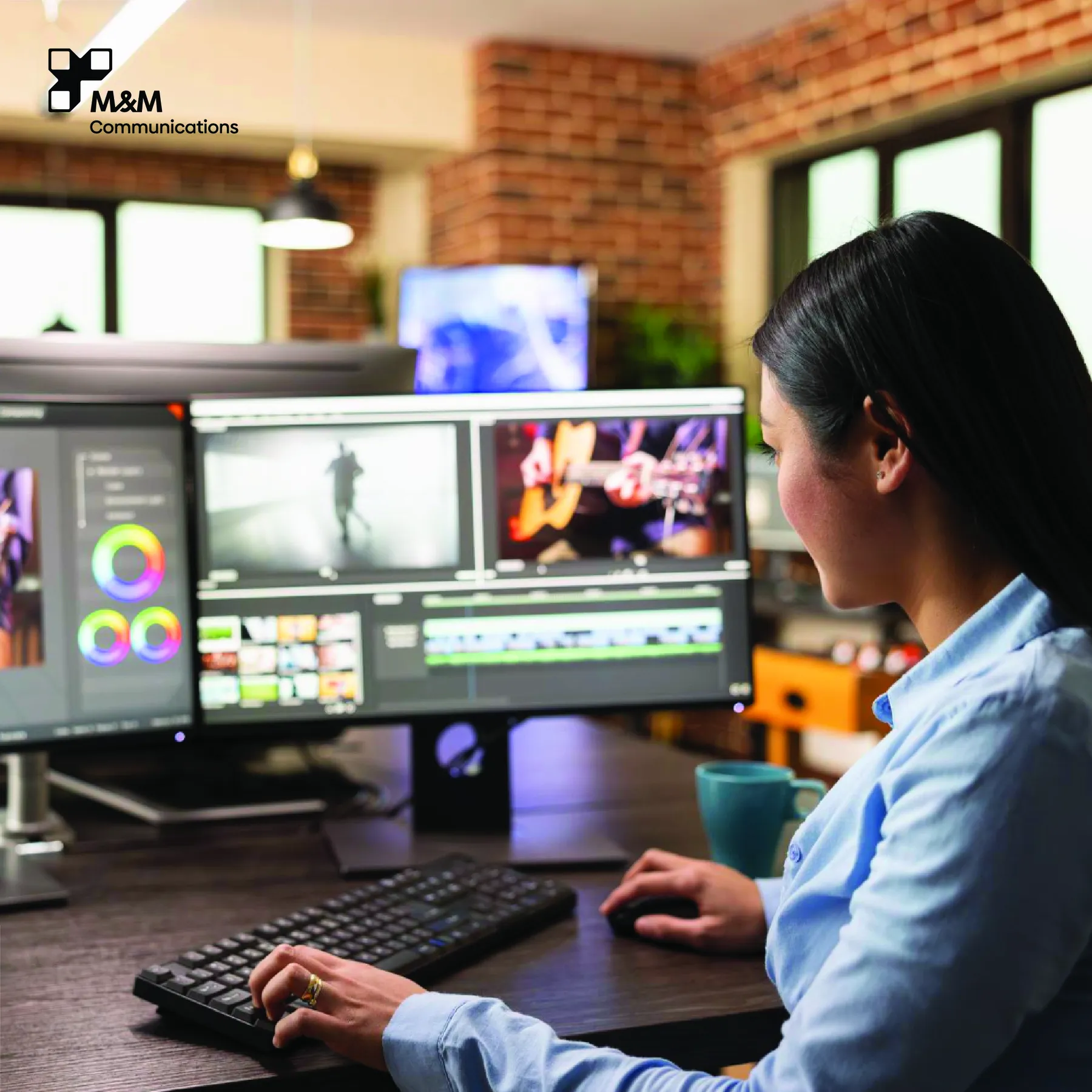
Video Studio Setup: Building Professional Video Production Spaces on Any Budget
Creating Professional Video Production Environments That Deliver Results
Building an effective video studio setup represents one of the most strategic investments for businesses committed to consistent, high-quality video content creation. At M&M Communications, we've designed and optimized video production spaces across diverse budget ranges and business requirements, understanding that successful studio design isn't just about expensive equipment—it's about creating inspirational and magical production environments that enable creative teams to produce professional content efficiently while maintaining the flexibility to adapt to changing content needs and creative challenges.
Understanding Video Studio Design Fundamentals
Effective video studio design balances technical requirements with creative workflow needs, ensuring optimal production efficiency while maintaining professional quality standards that reflect positively on brand image and content credibility.
The most successful studio setups prioritize flexibility and scalability, enabling diverse content creation—from corporate interviews to product demonstrations, educational content to marketing campaigns—without requiring complete equipment changes or extensive setup modifications.
Professional studio design also considers long-term business growth, content evolution, and technology advancement, creating infrastructure that can adapt to changing needs while protecting initial investment through thoughtful planning and modular equipment selection.
Budget-Based Studio Planning Framework
Starter Studio Setup: $5,000-10,000 Budget
Entry-level professional studios focus on essential equipment that delivers acceptable quality while providing upgrade pathways for future investment and capability expansion.
Camera Equipment: DSLR or mirrorless camera with video capabilities (Canon EOS M50, Sony A6400), basic lens kit including 50mm and 18-55mm options, and sturdy tripod with fluid head for smooth movement.
Audio Solutions: USB condenser microphone for interviews, lavalier wireless system for mobile recording, and basic audio monitoring headphones for quality control during production.
Lighting Kit: Three-point LED lighting kit with softboxes, background lighting for separation, and practical lighting accessories including reflectors and diffusers for natural-looking illumination.
Production Accessories: Basic backdrop stand with multiple background options, cable management solutions, memory cards, backup batteries, and basic editing software for post-production workflow.
Intermediate Studio Setup: $15,000-30,000 Budget
Mid-range studios enable professional quality production with enhanced creative flexibility and improved workflow efficiency for regular content creation demands.
Advanced Camera Systems: Professional mirrorless or cinema camera (Sony FX6, Canon C70), prime lens collection for creative flexibility, and multi-camera setup capability for dynamic content creation.
Professional Audio Infrastructure: Audio mixing board, multiple microphone options including shotgun and lavalier systems, professional monitoring speakers, and acoustic treatment for controlled sound environment.
Enhanced Lighting Design: Professional LED panel systems with color temperature control, motorized background systems, and advanced lighting modifiers for creative control and professional aesthetic achievement.
Production Infrastructure: Professional backdrop systems, teleprompter for scripted content, cable management and power distribution systems, and comprehensive storage solutions for efficient workflow management.
Professional Studio Setup: $50,000+ Budget
High-end studios provide broadcast-quality capabilities with comprehensive production infrastructure for demanding commercial and broadcast applications.
Broadcast-Quality Cameras: Multiple professional cameras with switching capabilities, comprehensive lens collections, and advanced stabilization systems for dynamic content creation.
Professional Audio Post-Production: Complete audio post-production setup including professional mixing consoles, studio monitors, and comprehensive microphone collections for diverse recording applications.
Advanced Lighting Control: Motorized lighting systems with remote control, comprehensive lighting modifier collections, and programmable lighting scenes for efficient production workflow.
Complete Production Infrastructure: Green screen capabilities, virtual set technology, professional editing suites, and comprehensive storage and backup systems for enterprise-level content production.
Space Planning and Acoustic Considerations
Optimal Room Selection and Layout
Choose studio spaces based on size requirements, acoustic properties, and natural light control rather than convenience alone. Minimum recommended space: 12x15 feet for basic interviews, 20x25 feet for comprehensive production capabilities.
Consider ceiling height for lighting equipment and backdrop flexibility: minimum 9 feet recommended, 12+ feet optimal for professional lighting setup and creative flexibility.
Evaluate existing acoustic properties including hard surfaces, echo potential, and external noise sources that may require treatment or mitigation for professional audio recording.
Acoustic Treatment Solutions
Implement acoustic treatment that improves audio quality without creating unnaturally dead sound environments that feel uncomfortable for talent or interviewees.
Budget-Friendly Options: Heavy curtains, acoustic foam panels, carpeting, and furniture placement for basic sound improvement without significant investment.
Professional Solutions: Custom acoustic panels, bass traps, diffusers, and floating floors for comprehensive sound control and professional audio environment creation.
Balance acoustic treatment with visual aesthetics, ensuring studio spaces feel professional and welcoming rather than industrial or uninviting for talent and clients.
Equipment Selection and Optimization Strategies
Camera Technology and Future-Proofing
Select camera systems based on content requirements, upgrade pathways, and long-term technology trends rather than current specifications alone.
Prioritize cameras with strong low-light performance, reliable autofocus, and comprehensive codec options that provide professional results across diverse shooting conditions.
Consider lens ecosystem and accessory availability when selecting camera platforms, ensuring long-term support and upgrade options that protect initial investment.
Audio Equipment Prioritization
Invest disproportionately in audio equipment quality, as poor audio damages content credibility more quickly than moderate video quality limitations.
Select microphone systems based on primary content types: lavalier systems for interviews, shotgun mics for narrative content, and USB solutions for direct recording applications.
Include audio monitoring capabilities and basic mixing equipment that enables real-time audio quality control during production rather than discovering problems during post-production.
Lighting System Design
Design lighting systems for flexibility and efficiency rather than maximum power alone, enabling diverse content creation without extensive setup changes.
Select LED lighting systems for consistent color temperature, energy efficiency, and heat management that creates comfortable production environments for extended shooting sessions.
Include lighting modifiers and control accessories that enable creative lighting design and professional aesthetic achievement across different content requirements.
Workflow Optimization and Efficiency Systems
Pre-Production Workflow
Develop standardized pre-production checklists and setup procedures that ensure consistent quality while minimizing production time and technical problems.
Create equipment check and maintenance schedules that prevent technical failures during production while extending equipment lifespan through proper care and handling.
Establish content planning and shot list systems that maximize studio efficiency while ensuring comprehensive content capture during scheduled production sessions.
Production Efficiency Systems
Design cable management and equipment storage systems that enable rapid setup changes and equipment access without disrupting ongoing production workflow.
Create lighting preset systems and camera position markers that enable consistent setups while reducing production time and maintaining professional quality standards.
Implement backup systems and redundancy planning that prevents production delays due to equipment failures or technical problems during critical production sessions.
This approach aligns with M&M Communications' philosophy: we don't create studio environments that prioritize equipment over creativity. Instead, we design inspirational and magical production spaces that enable creative teams to focus on storytelling excellence while technical infrastructure supports rather than hinders creative expression and professional content creation.
Technology Integration and Connectivity
Network Infrastructure and Connectivity
Install robust internet connectivity and network infrastructure that supports live streaming, cloud storage, and remote collaboration without compromising production workflow.
Include adequate power distribution and surge protection that prevents equipment damage while supporting intensive production equipment requirements safely and reliably.
Plan for future technology integration including remote production capabilities, cloud-based editing workflow, and emerging production technologies that may enhance studio capabilities.
Storage and Data Management
Implement comprehensive storage solutions including local storage for active projects, network-attached storage for collaboration, and cloud backup for security and accessibility.
Create data management workflows that ensure content security while enabling efficient collaboration and project handoff between team members and external partners.
Plan storage capacity based on content volume projections and retention requirements rather than current needs alone, ensuring adequate capacity for business growth and content archiving.
Safety and Compliance Considerations
Electrical Safety and Power Management
Ensure adequate electrical capacity and proper circuit distribution for production equipment while meeting local electrical codes and safety requirements.
Implement proper grounding and surge protection that protects expensive equipment while ensuring safe operation during intensive production sessions.
Include emergency power shutdown systems and proper ventilation for equipment cooling and safe operation during extended production periods.
Insurance and Equipment Protection
Obtain appropriate insurance coverage for production equipment, studio space, and liability protection that covers commercial content creation activities and client interactions.
Implement security systems and equipment protection measures that prevent theft while enabling efficient access for authorized team members and production partners.
Studio Layout and Design Optimization
Flexible Set Design and Background Options
Create modular set design systems that enable diverse content creation without requiring complete studio reconfiguration for different content types or client requirements.
Include multiple background options including solid colors, textured walls, and green screen capabilities that support various content aesthetics and post-production requirements.
Design furniture and prop storage systems that enable quick set changes while maintaining organized, professional studio appearance during client visits and production sessions.
Client Comfort and Professional Presentation
Design studio spaces that feel professional and welcoming for clients and talent rather than purely functional production environments that may feel intimidating or uncomfortable.
Include client seating areas, refreshment facilities, and professional presentation elements that enhance client experience while maintaining production efficiency and workflow organization.
Create tour-friendly studio layouts that showcase professional capabilities while maintaining security and equipment protection during client visits and business development activities.
Maintenance and Upgrade Planning
Equipment Maintenance and Longevity
Establish regular maintenance schedules and procedures that extend equipment lifespan while preventing production delays due to preventable equipment failures or performance degradation.
Create equipment replacement and upgrade timelines that maintain technological competitiveness while maximizing return on initial investment through strategic replacement timing.
Document equipment performance and maintenance history that informs future purchasing decisions while enabling efficient troubleshooting and warranty management.
Scalability and Growth Planning
Design studio infrastructure that can accommodate business growth and changing content requirements without requiring complete rebuilding or equipment replacement.
Plan upgrade pathways that enable capability enhancement through strategic equipment additions rather than wholesale system replacement that might disrupt ongoing production activities.
ROI Measurement and Studio Optimization
Production Efficiency Metrics
Track production time improvements, content quality enhancements, and client satisfaction improvements that demonstrate studio investment value and optimization opportunities.
Monitor equipment utilization rates and production capacity to identify bottlenecks and optimization opportunities that improve studio efficiency and return on investment.
Measure content quality improvements and client feedback that indicate successful studio design and equipment selection decisions.
Business Impact Assessment
Evaluate studio impact on business development, client acquisition, and content marketing effectiveness to understand comprehensive studio investment value beyond production efficiency alone.
Track revenue attribution to studio capabilities and content quality improvements that justify continued investment and optimization of studio infrastructure and capabilities.
Future Trends in Studio Design
Virtual and Hybrid Production
Emerging virtual production technologies enable sophisticated content creation while reducing location shooting requirements and production complexity.
AI-Enhanced Production Workflow
Artificial intelligence increasingly automates technical production tasks while enabling more sophisticated content creation and post-production optimization.
Conclusion: Building Studios That Enable Creative Excellence
Professional video studio setup requires strategic planning, thoughtful equipment selection, and workflow optimization that enables consistent, high-quality content creation while supporting business growth and creative evolution.
At M&M Communications, we understand that exceptional studios aren't built around expensive equipment alone—they're designed as inspirational and magical creative environments that enable teams to produce outstanding content efficiently while maintaining the flexibility to adapt to changing business needs and creative challenges.
The future belongs to studios that can balance technical excellence with creative flexibility, enabling diverse content creation while maintaining professional quality standards. Invest in strategic studio design today, and discover how professional production environments can transform your content capabilities and business growth potential.






